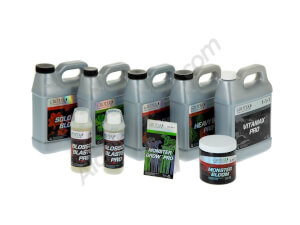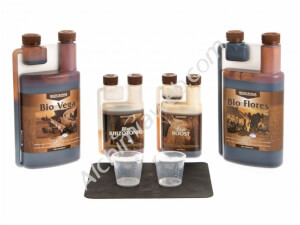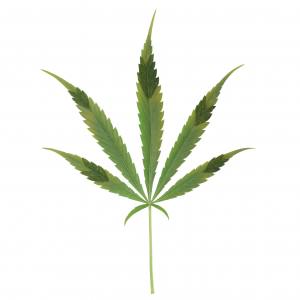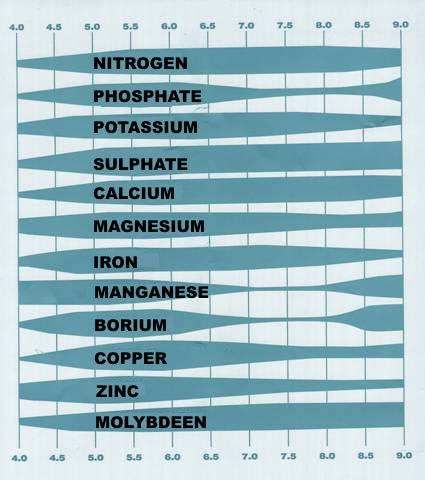Micronutrients and Marijuana plants
List of contents
If you are a cannabis grower, you will know that every detail counts for healthy plants and abundant harvests. Among the many factors that influence plant development, micronutrients play an essential but often underestimated role; However, these small but powerful substances, which include minerals such as boron, zinc, sulfur, and manganese, are essential for numerous metabolic processes and vital functions of cannabis plants.
In this article, we will explore the importance of these nutrients and their functions in the crop, the symptoms of deficiency and excess, as well as best practices to ensure that the supply of these elements is optimal and balanced, ensuring that everything will run smoothly. And, as you will see, micronutrients can make the difference between a mediocre crop and an extraordinary one!
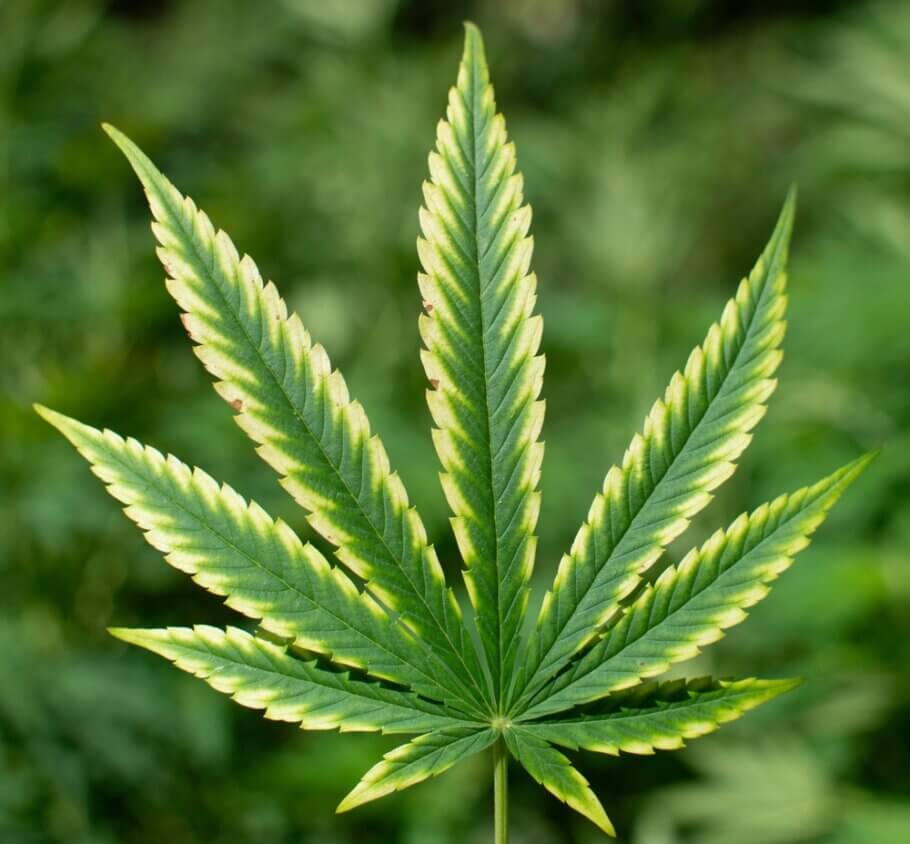
Micronutrients in cannabis plants
In general terms, if it is grown in a substrate suitable for growing cannabis and with balanced fertilizers, the plants should not suffer from excesses or deficiencies of any kind, although it is always better to know these deficiencies and excesses in marijuana.
Micronutrients are those nutrients that the plant needs in low quantities compared to macronutrients, which are required in much higher amounts. However, they are no less important, and these foods are necessary for the correct development of the plants' metabolism, since without them many of their vital functions could not be carried out.
Some of these functions or processes include:
- Photosynthesis: Micronutrients, such as iron and manganese, are key components of enzymes involved in photosynthesis, the process by which plants convert sunlight, water, and carbon dioxide into energy
- Chlorophyll formation: Zinc is directly related to the formation of chlorophyll, the green pigment responsible for capturing light energy during photosynthesis
- Cellular respiration: Several micronutrients, such as iron, zinc, and copper, participate in metabolic reactions associated with cellular respiration, which is the process by which plants obtain energy from nutrients
- Protein formation: Micronutrients are necessary for the synthesis of proteins, which are essential for the growth and development of plants.
- pH regulation and nutrient transport: Some micronutrients, such as manganese and zinc, help regulate the pH balance in plant cells and facilitate the transport of other nutrients across cell membranes
Deficiency and excess of zinc in cannabis
Zinc is a necessary element for marijuana plants since it interacts directly with the creation of chlorophyll, and is also directly related to the creation of auxins and growth hormones. It should be said that the assimilation of zinc will depend on the pH of the substrate and the concentration of phosphates that may be present in other nutrients, as in the case of excess phosphorus.
Zinc is absorbed by plants in the form of a divalent ion (Zn2+), and is also easily absorbed from the epidermis and branches. In soils with a very acidic pH, zinc will not be able to be absorbed and transferred from the roots to the aerial part of the plant, as well as in substrates exposed to low temperatures and prolonged humidity caused by constant rains.
Detection/Solution:
- Zinc deficiency is detected by observing the appearance of chlorosis in the youngest leaves of the plant. Burns appear on the edges of the leaves and the plants suffer very slow development.
- Abnormalities are found in the development of the leaves, lengthening along with a reduction in the internodal distance while the leaves tend to make rosettes.
- To solve this zinc deficiency, we can apply a root wash with enzymes to relieve any type of blockage derived from another nutritional element and use fertilizers rich in rapidly absorbed macro and microelements.
- If the deficiency is advanced, a zinc mono nutrient can be sprayed on the leaves for greater assimilation by the plant.
- An excess of zinc causes very rapid death in plants due to its great toxicity. Iron deficiencies can also be caused by an excess of zinc.
A solution to excess zinc: The solution to excess involves carrying out a root wash with a stable pH along with a salt breaker to help clean the substrate. Subsequently, a light and complete fertilization with macro and micro elements will be carried out.
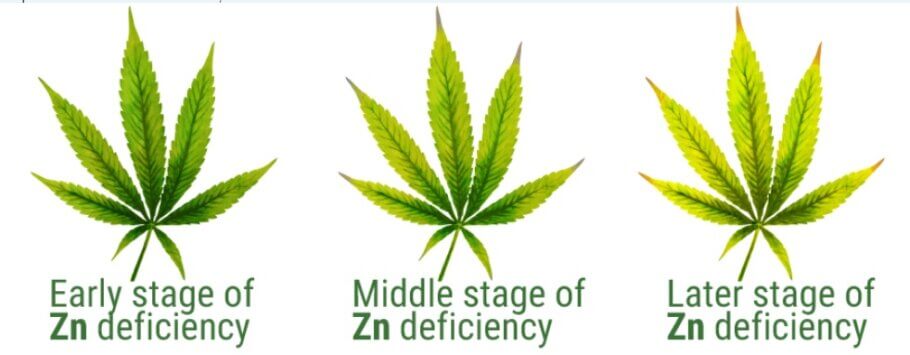
Deficiency and excess of boron in cannabis
Boron is a nutritional element necessary for the development of many of the physiological functions of marijuana plants, such as the formation of the cell wall. It is an element that is very difficult to move through the plant so its deficiencies will be detectable in the youngest shoots, although it must be said that when it is well absorbed the youngest parts have twice the amount of this element as the older leaves. old
It should also be noted that boron will be absorbable by the plant with a stable pH of 5.0 to 7.0 points and will help in the stability of other elements, avoiding, for example, calcium deficiency, in addition to contributing to the modification of some processes. hormonal, such as in the flowering and fruiting of the buds. The ovaries of female flowers widen the ducts, facilitating the entry of pollen for better fertilization and seed creation.
The excess of other nutritional elements, as in the case of nitrogen, will cause a blockage of boron which will result in a clear lack of this element, that is, even if the food is in the substrate it will not be available to the plants.
Detection/Solution
- Abnormal growth of plant limbs, roots swell and stop growing. Burns appear on the leaves of the plants that can be confused with the typical burns caused by heat irradiation from the HPS focus. Necrosis develops between the nerves, and the roots become soft, facilitating the appearance of possible fungi. The leaves increase in thickness, being decayed with chlorosis and necrosis.
- A high concentration of calcium causes calcium borates that are poorly soluble for plants.
- Excess organic matter causes boron to be retained in complex forms that release boron very slowly.
- Sandy substrates with a great abundance of water may have a deficiency given the ease with which boron is carried away from the substrate.
- In cases where severe drought occurs, the elements rise to the substrate by capillarity, making the boron inaccessible to the roots.
- To treat boron deficiency we can give plants a tablespoon of boric acid every 4 liters of water or water with chelated fertilizers rich in boron.
- Excess boron is detected visually through the yellowing of the leaves. The edges of the leaves become necrotic towards the center of the leaf. There are insecticides that may contain high concentrations of boric acid, avoid contact with insecticides on the substrate
A solution to excess boron: To solve the excess, a root wash must be carried out with a stable pH of 6.0 and three times as much water as the capacity of the pot. You can use enzymes to facilitate the process.
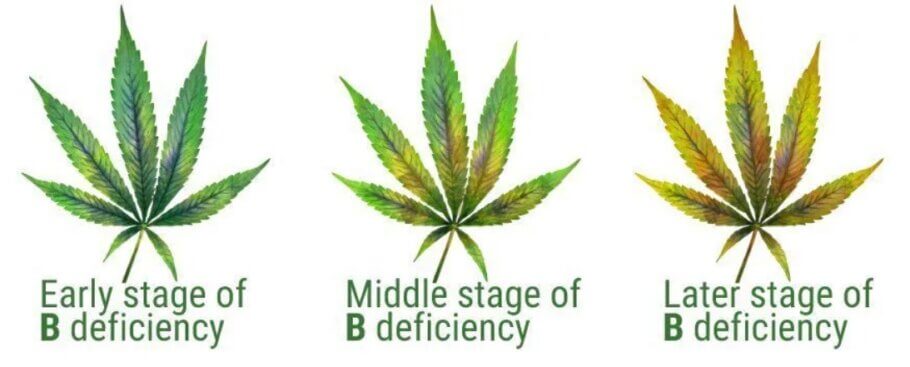
Deficiency and excess of sulfur in cannabis
Sulfur deficiency is very rare in marijuana crops if it is grown with an enriched substrate from the beginning. However, it can be common in heavily exploited soils that have not been renovated over the years.
In the case of suffering a deficiency of this nutrient, we must make sure that it is not a nitrogen deficiency, since it is very similar in its detection, although in this case the discoloration/chlorosis occurs in the leaves of the upper part of the plant, which turn yellow.
As it progresses, it can affect the middle/lower part of the plant, confusing it with nitrogen deficiency. So early detection will avoid confusion with nitrogen deficiency.
Detection/Solution
- The leaves of the plants acquire a lime green color, turning yellowish, with the youngest leaves being the first to be affected. The stems become woody, and purple, and are followed by an excess of calcium while, in turn, this excess blocks the absorption of sulfur.
- This lack of sulfur is solved with irrigation rich in sulfur in mineral format for rapid absorption of this element, with a stable pH depending on the growing medium used.
- Excess sulfur is denoted in the plant by slow growth and development of smaller plant leaves, along with chlorosis on the tips and edges if the excess is severe.
Solution to excess sulfur: Clean the substrate with three times as much water as the capacity of the pot to follow a light fertilization rich in micro and macro elements. Use enzymes to make the process more effective.
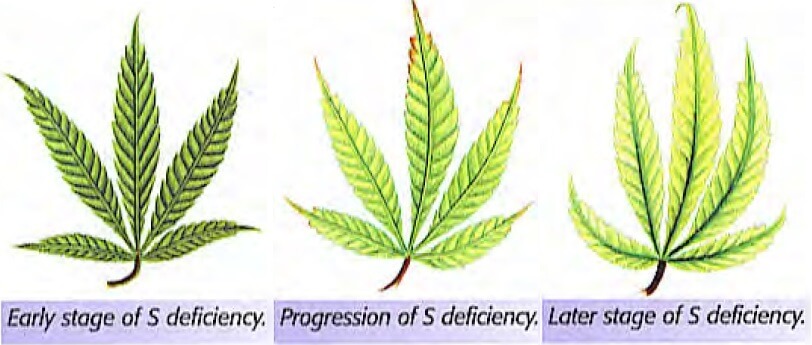
Deficiency and excess of manganese in cannabis
Manganese is a microelement responsible for the transport of electrons in photosynthesis. Manganese is absorbed by the plant through its leaves and roots, having the ability to change its oxidation state and at the same time being able to participate in several enzymatic oxidation-reduction processes dedicated to facilitating the exchange and transport of ions.
Another of its functions is to intervene in photosynthesis, forming part of a mangano-protein that will be responsible for the photolysis of water and the creation of O2. It can also perform functions such as those of magnesium as a co-factor in enzymatic systems with redox-type reactions, decarboxylations, hydrolysis along with energy transfer, acting as a bridge ion for ATM (Adenosine Triphosphate, the first energy molecule synthesized by the plant).
It also acts in the nitrate reduction phase as a plant response to many of the possible sources of stress that can occur during cultivation, such as anoxia (lack of oxygen), excess salts, drought, or nutrition with excess ammonia.
Detection/Solution
- The deficiency is initially detected in the youngest leaves and progresses to the oldest leaves, with almost no growth and slow flowering.
- To solve the deficiency, we must stabilize the pH of the substrate and water with fast-absorbing fertilizers rich in microelements.
- An excess of manganese acts by creating orange spots on the leaves, which turn brown as the excess progresses. Additionally, a deficiency of zinc and iron occurs due to the blockage of excess manganese.
A solution to excess manganese: The solution to excess is to wash the roots with three times as much water as the capacity of the pot with a stable PH according to the substrate.
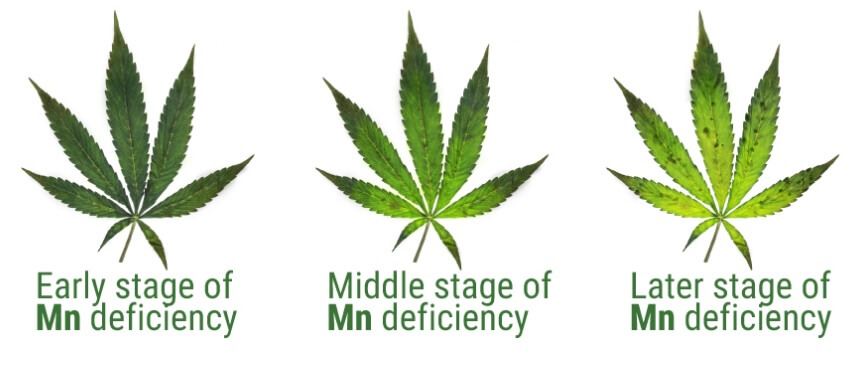
Happy harvest!

















































